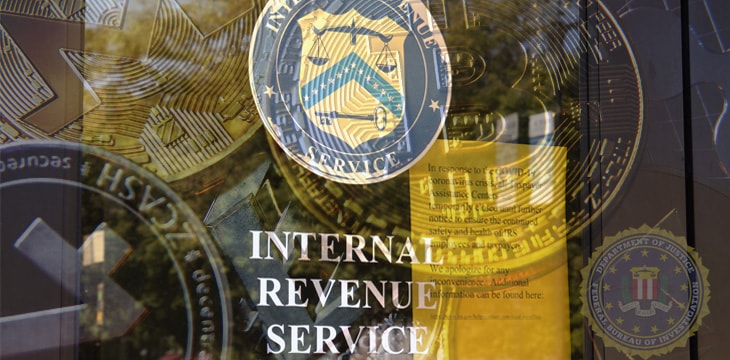|
Getting your Trinity Audio player ready...
|
In a move that shouldn’t surprise anyone, the U.S. Internal Revenue Service Criminal Investigation Division (IRS-CI) is seeking more information about so-called “privacy coins” and other technologies that obfuscate digital asset transactions. These include several blockchains specifically created to be anonymous, plus additions to well-known assets like BTC and BCH that altered the way transactions are performed.
The request for information (RFI) document published on June 30, 2020, also contains a call for demonstrations of investigative technologies that would help it combat transaction and identity obfuscation.
https://twitter.com/W3stW1ck3dW1tch/status/1280435776363343873
It’s a clear sign the federal government is aware of these technologies and their purpose, and is concerned at their increasing use in criminal activity. It is prepared to direct its resources not only into tracing illicit transactions, but also showing that it can do so in an effort to deter would-be criminals from using them.
Many in the Bitcoin (BSV) community, most notably Dr. Craig Wright, have long pointed out that anonymity is untenable in digital transactions in the years ahead. It is one of the several reasons all BSV transactions stay on-chain and auditable on a truly scalable network. The IRS and other government institutions will likely, in time, either gain the technology to better trace “private” transactions—or make other moves to curtail their use.
Much energy, effort and money has poured into developing technologies that promote anonymity or “financial privacy” over the past decade. However it’s hard to see how that effort could be worthwhile, given governments’ near-zero tolerance for untraceable transactions. Even if they were successful at staying ahead in the inevitable cat-and-mouse game they’d play with law enforcement agencies, they’d be confined to the fringes of finance and remain forever under suspicion.
Privacy coins, BTC’s Lightning Network, BCH’s Schnorr signatures
IRS-CI Cyber Crimes Cryptocurrency Initiative listed the following assets and technologies in its request by name:
“Monero (XMR), Zcash (ZEC), Dash (DASH), Grin (GRIN), Komodo (KMD), Verge (XVG), and Horizon (ZEN), privacy cryptocurrency coins (e.g., Monero (XMR), Zcash (ZEC), Dash (DASH), Grin (GRIN), Komodo (KMD), Verge (XVG), and Horizon (ZEN)); Layer 2 off-chain protocol networks (e.g., Lightning Network (LN), Raiden Network, Celer Network); Side-chains (e.g., Plasma and OmiseGo); and tracing challenges following the integration of the Schnorr Signature algorithm.”
Notably, this list includes some of today’s most well-known digital assets and technologies others have added in an attempt to scale their networks or make transactions less traceable. Lightning Network is touted as the primary “Layer 2” network to handle most BTC transactions, and Raiden Network does a similar job for Ethereum.
BCH started implementing Schnorr signatures in its May 2019 upgrade/hard fork. This was promoted as an alternative to Bitcoin’s ECDSA signatures that increased privacy by obfuscating transaction types on the network—making it harder to determine whether they’re for asset swaps, smart contracts, payment channels, or ordinary payments.
Looking for more information and new investigative techniques
IRS-CI admitted in the document that it currently has “few investigative resources for tracing transactions” using the above technologies, and that the resources it does have need to be more efficient.
It acknowledged that Lightning Labs, which created the Lightning Network, has developed a monitoring app called Lndmon for the BTC network, but none have yet been developed for similar transaction layers on Litecoin or Ethereum. However it also noted “clear evidence” that Lightning Network nodes and users were increasing.
IRS-CI is seeking input of all kinds on these technologies, including advice or research on forensic techniques like transaction clustering, possible new techniques, prototype technologies, plus feasibility and cost estimates should these be implemented.
Mixed and private coins become ‘tainted’ for all users
Investigating and tracing use of these technologies, including others designed to obfuscate transaction information and user identities (such as “coin mixers” even on on-chain records) would have side effects for all users. They could possibly “taint” assets and/or draw extra law enforcement attention to users not engaging in other illegal activities.
As Dr. Craig Wright has pointed out more recently, a court could even order particular UTXOs to be frozen without knowing who was behind them.
As for Schnorr signatures, he said: “it just taints all inputs. The way tracing works is to match it against all the outputs—so now, one single tainted input in 100 inputs renders all coins bad and loses all holders value.”
For on-chain transactions like Bitcoin (BSV), investigation is more straightforward and forensic investigation techniques have been improving for years. Companies like Chainalysis and CipherTrace have formed specifically to assist investigators and have been successful at unmasking criminals using darknet marketplaces, performing ransomware attacks and other thefts, money laundering crimes, and more.
Complicating transactions with privacy coins, Layer 2 networks or sidechains may be slowing investigators down for now. But as investigative techniques evolve—and the IRS is showing clear intent to make this happen—they will eventually only serve to make life difficult for everyone using those networks. Full anonymity for transactions is likely impossible and indeed undesirable, given that it would only increase opportunities to commit fraud and other crimes.
And remember, if it’s private for you then it’s just as private for those who would do you harm, including large criminal organizations, powerful-but-corrupt governments and officials, and large corporate bad actors.
Bitcoin keeps all BSV transactions on-chain, not only for simplicity and security, but also to make the system more transparent. It’s transparent for everyone, from individuals to powerful groups. A properly-scalable network is necessary to achieve this, making Bitcoin once again the only realistic technology to drive the digital economy of the future.

 12-17-2025
12-17-2025 




